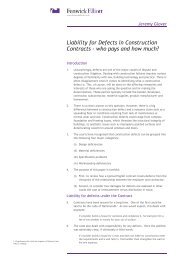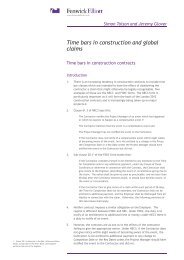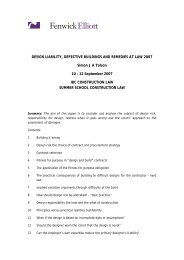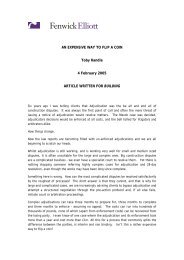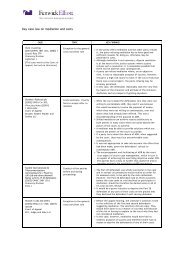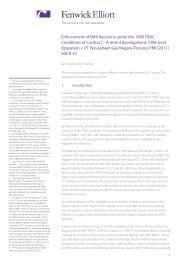Standard forms: JCT 2005, NEC3 and the Virtual ... - Fenwick Elliott
Standard forms: JCT 2005, NEC3 and the Virtual ... - Fenwick Elliott
Standard forms: JCT 2005, NEC3 and the Virtual ... - Fenwick Elliott
Create successful ePaper yourself
Turn your PDF publications into a flip-book with our unique Google optimized e-Paper software.
<strong>St<strong>and</strong>ard</strong> <strong>forms</strong>: <strong>JCT</strong> <strong>2005</strong>, <strong>NEC3</strong> <strong>and</strong> <strong>the</strong> <strong>Virtual</strong> Contract<br />
www.fenwickelliott.co.uk<br />
The <strong>2005</strong> suite of <strong>JCT</strong> Contracts have attempted to rationalise <strong>the</strong> approach of <strong>the</strong> earlier<br />
<strong>JCT</strong> Forms, as well as to deal with some issues that were quite simply previously omitted<br />
from <strong>the</strong> <strong>JCT</strong> documents. In terms of rationalisation, <strong>the</strong> contracts have been developed<br />
into consistent sections, such as payment, <strong>and</strong> this is an approach that must be welcomed.<br />
The appendix at <strong>the</strong> end of <strong>the</strong> old <strong>forms</strong> has now been moved to <strong>the</strong> front, so that all<br />
of <strong>the</strong> projects specific information is clearly placed at <strong>the</strong> beginning of <strong>the</strong> contract.<br />
Default provisions assist those that are perhaps not as familiar as completing st<strong>and</strong>ard<br />
<strong>forms</strong> as o<strong>the</strong>rs (such as complying with <strong>the</strong> Fire Code <strong>and</strong> <strong>the</strong> need or o<strong>the</strong>rwise for<br />
an advanced payment bond). Supplements have been integrated, for example sectional<br />
completion <strong>and</strong> <strong>the</strong> contractor’s designed portion supplement, while statutory backed or<br />
simply procedural provisions have been rightly removed. These include <strong>the</strong> construction<br />
industry scheme, <strong>and</strong> in particular <strong>the</strong> VAT supplements.<br />
The VAT Supplement was a lengthy document that only rarely re-stated <strong>the</strong> statutory<br />
provisions. The construction industry scheme was somewhat lengthy, <strong>and</strong> has been quite<br />
simply replaced with a short clause. 7<br />
<strong>JCT</strong> <strong>2005</strong> Design <strong>and</strong> Build Contract<br />
The <strong>JCT</strong> 1998 With Contractor’s Design Form was <strong>the</strong> most widely used st<strong>and</strong>ard form in<br />
<strong>the</strong> UK construction industry, <strong>and</strong> so in anticipation that <strong>the</strong> <strong>JCT</strong> <strong>2005</strong> Design <strong>and</strong> Build<br />
Contract may eventually replace it, it is perhaps worth focussing on <strong>the</strong> layout <strong>and</strong> terms<br />
of that contract.<br />
The contract particulars (replacing <strong>the</strong> appendices) appear at <strong>the</strong> very outset of <strong>the</strong><br />
contract, only preceded by <strong>the</strong> articles <strong>and</strong> recitals. The contract can be used for projects<br />
with sectional completion without modification, an improvement that must be welcomed.<br />
Third party rights is an addition to this form of contract, <strong>and</strong> <strong>the</strong> name class a description<br />
of person to whom a third party right is to be owed is set out in part 2 of <strong>the</strong> project<br />
particulars. The contractor should <strong>the</strong>refore be able to identify to whom <strong>the</strong> third party<br />
rights are owed, or to whom <strong>the</strong> collateral warranties are to be provided. In addition,<br />
those sub-contractors providing collateral warranties must also be identified.<br />
The conditions are <strong>the</strong>n divided neatly into nine sections. There are <strong>the</strong>n seven schedules.<br />
The sections comprise:<br />
7 Clause 4.7.<br />
• Section 1: Definitions <strong>and</strong> Interpretations;<br />
• Section 2: Carrying out <strong>the</strong> works; dealing with many of <strong>the</strong> main<br />
provisions such as <strong>the</strong> quality of works, possession, design<br />
liability, adjusting <strong>the</strong> completion date, practical completion,<br />
liquidated damages <strong>and</strong> so on;<br />
• Section 3: Control of <strong>the</strong> works;<br />
• Section 4: Payment;<br />
• Section 5: Changes, dealing in particular <strong>the</strong> valuation rules;<br />
• Section 6: Injury, damage <strong>and</strong> insurance;<br />
• Section 7: Assignment, third party rights <strong>and</strong> collateral warranties;<br />
• Section 8: Termination; <strong>and</strong><br />
• Section 9: Settlement of disputes<br />
7




